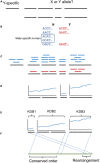Evidence of Recombination Suppression Blocks on the Y Chromosome of Date Palm (Phoenix dactylifera)
- PMID: 33959137
- PMCID: PMC8093805
- DOI: 10.3389/fpls.2021.634901
Evidence of Recombination Suppression Blocks on the Y Chromosome of Date Palm (Phoenix dactylifera)
Abstract
The genus Phoenix includes the fruit producing date palm tree among 14 species that are all dioecious. Females produce the fruit that are high in sugar content and used in multiple countries ranging from North Africa to South Asia, especially from the Phoenix dactylifera, Phoenix sylvestris, and Phoenix canariensis species. While females produce the fruit, understanding of the genetic basis of sex control only began recently. Through genus-wide sequencing of males and females we recently identified three genes that are conserved in all males and absent in all females of the genus and confirmed an XY sex chromosome system. While our previous study focused on conservation of male-specific sequences at the genus-level, it would be of interest to better understand the spread of male-specific sequences away from the core conserved male genes on the Y chromosome during speciation. To this end, we enumerated male-specific 16 bp sequences using three male/female pairs from the western subpopulation of date palm and documented the density of these sequences in contigs of a phased date palm genome assembly. Here we show that male specific sequences in the date palm Y chromosome have likely spread in defined events that appear as blocks of varying density with significant changes in density between them. Collinearity of genes in these blocks with oil palm shows high synteny with chromosome 10 between megabase 15 and 23 and reveals that large sections of the date palm Y chromosome have maintained the ancestral structure even as recombination has stopped between X and Y.
Keywords: Y chromosome strata; date palm; phased sequencing; recombination suppression; sex determination.
Copyright © 2021 Torres, Mohamoud, Younuskunju, Suhre and Malek.
Conflict of interest statement
The authors declare that the research was conducted in the absence of any commercial or financial relationships that could be construed as a potential conflict of interest.
Figures





References
-
- Beal J. M. (1937). Cytological Studies in the Genus Phoenix. Bot. Gaz. 99 400–407. 10.1086/334708 - DOI
LinkOut - more resources
Full Text Sources
Other Literature Sources

